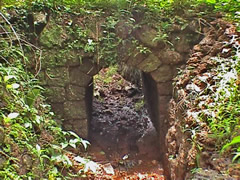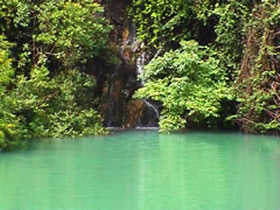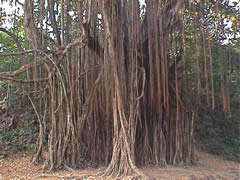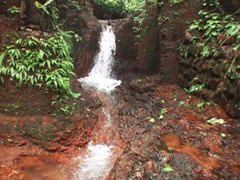Seven Sacred Springs:
Explorations around Assagao
By Chinmaya Dunster

Four down and three to go, I came to a dry-season hiatus. There are just so many empty gullies running down the hillsides to join the Vau, most of them strewn with garbage as they pass the farms and houses at the roadsides. They channel Goa’s three meters of rain during the monsoon, but now they were blocked with a tangle of thorns and fallen branches. Following each one up to a doubtful source at a spring would be an impossible task. A pond in a ricefield near my home in Sauta Vaddo provided a respite and a potential number five. Its roughly circular banks are lined with laterite blocks, overgrown with weeds and slim trees that provide shade. With even the Vau in this season a mere trickle, and the well at our house providing just a last gasp of muddy water, the pond’s source must be deep underground for it brims with clear, cold water. I swam in it daily, often with my three year-old daughter, and could arrive back home cooled down enough to survive the desperate heat of the pre-monsoon afternoons. Should I count this as number five?
 laterite bridge
laterite bridgePhoto: Chinmaya Dunster
The arrival of the monsoon in early June provided a wealth of information for my search, as the brush and garbage-choked gullies cleared by runoff. Now I could distinguish between those that flowed only for a short time after a heavy shower, and those that maintained their flow during drier spells, indicating underground recharge. Back at Sonarkhed, I tracked the courses of two further monsoon-fed streams, and just above the junction point in mature forest on the Siolim boundary, I found the prettiest hill spring yet. A deep pool of clear turquoise water bubbled away over bright yellowish-orange laterite to join the main channel. I drank it greedily, its exquisite taste better than anything money could buy after my sweaty trek over the hills. This spring is not forgotten, for there are signs of the local people using it to do their washing, while the well-worn track past it leads to a rectangular basin cut out of the bedrock, used for the distillation of feni (cashew alcohol) and still stained with cashew juice from the past harvest.
 Badem Spring pool
Badem Spring poolPhoto: Chinmaya Dunster
The book provided me with my final clue-- or perhaps it was not to be final, if the valley pool near my house was not to be counted amongst the seven. The neighbouring village of Badem had been part of Assagao parish until a separate church was consecrated for it half a century ago, and still came under Assagao’s local government. The only patches of forest there deep enough to hide a spring lie in a thin strip on the northern side facing the Chaporra estuary. It was a simple matter to establish that a waterfall, which flows into a wide pool formed at the site of an old quarry, is the only waterflow of sufficient size to be powered by a spring rather than stormwater runoff. What was not so simple was to get on top to check the source of the stream feeding the falls. The water ran in a narrow V-shaped gully over sheer quarried rock faces; the monsoon had by now been in full swing for over a month and all traces of paths had been hidden under new growth. I abandoned the attempt and contented myself with clambering my way to a clear view of the falls from below.
By now, I had become a bit obsessed. Had I in fact identified seven mineral-rich hill springs? The pool in the ricefields near my home at Sauta Vaddo was hardly a hill spring, was it? My Scorpionic love of uncovering the hidden led me on, together with the fact that in these monsoon days there was not much else going on to fill my time. I drove again around the village lanes peering into gulches; there was simply only one more possibility, and it lay just outside Assagao. It was to prove an equal to the Valle in terms of its fascination.
 banyan tree
banyan treePhoto: Chinmaya Dunster
Consoling myself with the thought that, after all, the area might once have been considered part of Assagao, I crossed over from the Dossazor along the hillslopes into the neighbouring parish of Anjuna, striking for a shallow side valley that discharges into the central flats along the Vau. It was a short hike (I had hardly left Assagao really, had I?) until below me tall forest marked the stream’s course. I worked my way down, with the usual probes into the impossible tangle of monsoon foliage along the course, hoping to glimpse the signs of human intervention. Suddenly they were all before me: laterite walls, a gigantic banyan, the sound of cascading water, and a curious white marble chappati plate, embossed with a flower motif, lying abandoned in the streambed.
Easing past the banyan’s arial roots, I looked down onto a waterfall in a cleft in the rock which had been carefully shaped until its walls were vertical. The cleft opened out into a wider space, its sides also hewn into the vertical. Openings at the side, now filled with mud and debris, as well as rectangular pits in the streambed itself, all showed signs of having been carved into shape out of the living rock.
 Anjuna Spring
Anjuna SpringPhoto: Chinmaya Dunster
I went back many times, pondering the efforts a small community must have put into fashioning the place. It too must have been part of that valley-wide irrigation project which had once fed the whole village, and signs of which I had seen all over my wanderings in search of springs. But then where were the tumbled-down remains of a dam to contain the water? Or of channels to conduct it? And why such a concern with exact verticals? The presence of that great banyan reminds me that, however purely utilitarian the place’s function once was, the people who made it (and maintained it until the recent advent of government-piped water, diesel pumps and alternative employment in the tourist industry) had a veneration and respect for water, trees and the powers of the natural world that went beyond their mere usefulness. They modified the land they occupied with an aesthetic that shows how finely tuned their senses were to the sacred.
About the author

Chinmaya Dunster is a world-renowned musician, writer, artist and filmmaker. He traveled from England to India in the 1970s, where he fell in love with Osho, the sarod and Indian classical music. Over the next several decades, he explored the crossroads between Indian classical and various Wetern musical traditions, released more than a dozen CDs, and created films dedicated to spreading a message of conservation in India. He currently lives with his family in New Zealand.
For links to Chinmaya's music, films and current projects: www.chinmaya-dunster.com
Did you like the article? Subscribe here to our New Article Email Alert or RSS feeds.
Sharing is caring! Don't forget to share the love, and keep the conversation going by leaving a comment below:
Advertisement
